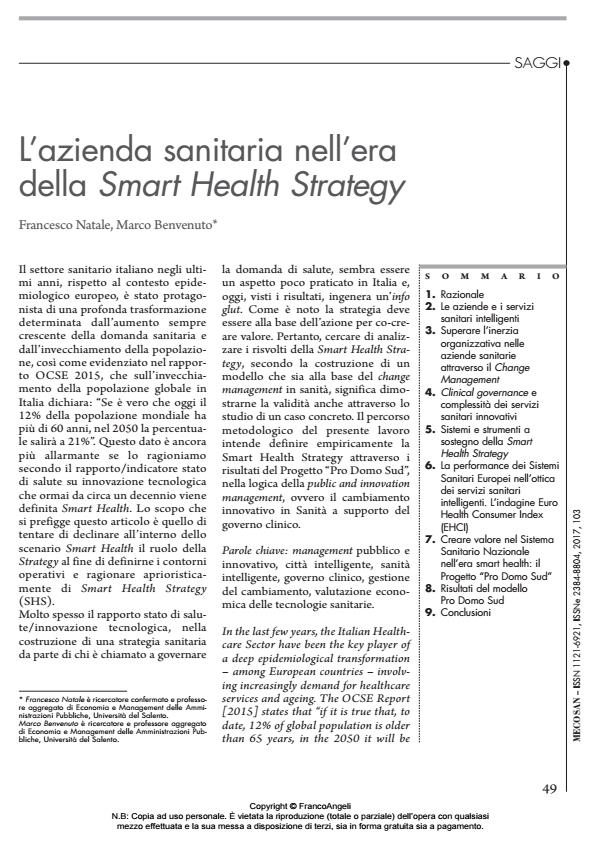L’azienda sanitaria nell’era della Smart Health Strategy
Journal title MECOSAN
Author/s Francesco Natale, Marco Benvenuto
Publishing Year 2018 Issue 2017/103
Language Italian Pages 24 P. 49-72 File size 24101 KB
DOI 10.3280/MESA2017-103004
DOI is like a bar code for intellectual property: to have more infomation
click here
Below, you can see the article first page
If you want to buy this article in PDF format, you can do it, following the instructions to buy download credits

FrancoAngeli is member of Publishers International Linking Association, Inc (PILA), a not-for-profit association which run the CrossRef service enabling links to and from online scholarly content.
In the last few years, the Italian HealthcareSector have been the key player ofa deep epidemiological transformation - among European countries - involvingincreasingly demand for healthcareservices and ageing. The OCSE Report[2015] states that "if it is true that, todate, 12% of global population is olderthan 65 years, in the 2050 it will be 21%", this declaration will be evenmore serious if we consider the impacton the ratio between health status andtechnology innovation (since a decadeknown as Smart Health). The mainpurpose of this paper is to try to definethe role of the strategy in the SmartHealth scenario, in order to describethe operative outlines and to discuss apriori about the Smart Health Strategy(SHS).Even more, the ratio between healthstatus and technology innovation inbuilding of a healthcare strategy seemsto be an unused aspect in Italy: nowadays,it produce an info glut, especiallyby the side of the decision maker andthe management of healthcare demand.As is well known, the strategy is importantto co-create value. Therefore, analysingimplications of Smart HealthStrategy, according to the constructionof a model that is at the base of ChangeManagement in Healthcare, requiredemonstrating its effectiveness throughan empirical study. With the findings of"Pro Domo Sud" Project", we want todefine Smart Health Strategy accordingto the logic of "public and innovationmanagement", that is the innovativechange in healthcare to support clinicalgovernment.
Keywords: Public and innovation management,smart city, smart health, clinicalgovernance, change management,health technology assessment.
Francesco Natale, Marco Benvenuto, L’azienda sanitaria nell’era della Smart Health Strategy in "MECOSAN" 103/2017, pp 49-72, DOI: 10.3280/MESA2017-103004